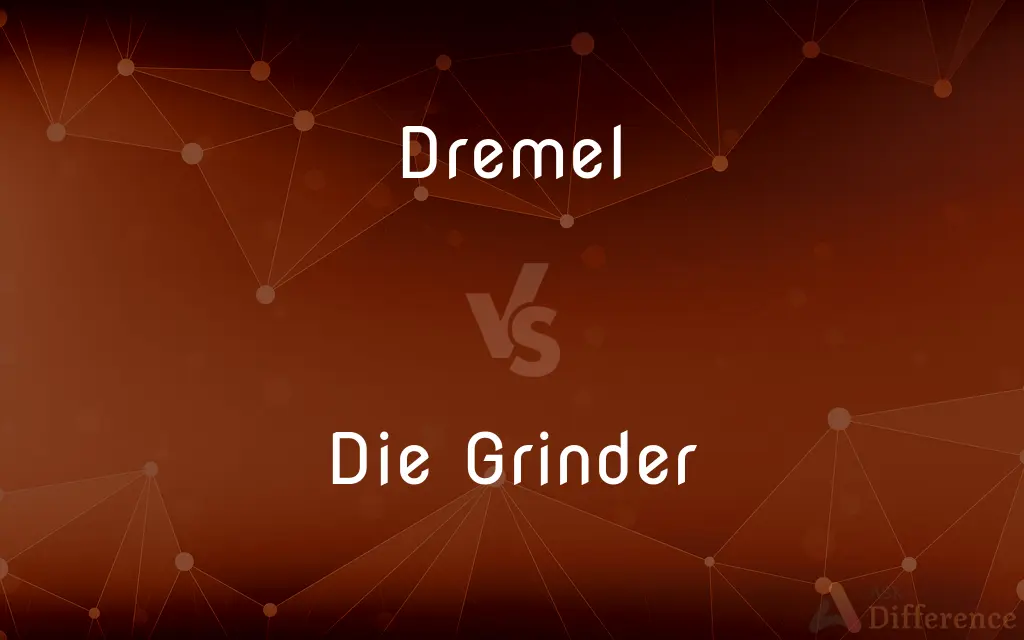Dremel vs. Die Grinder — What's the Difference?
By Tayyaba Rehman — Published on January 25, 2024
A Dremel is a brand of rotary tool known for its versatility in light tasks, while a die grinder is a more powerful tool used for heavy-duty grinding, cutting, and shaping.

Difference Between Dremel and Die Grinder
Table of Contents
ADVERTISEMENT
Key Differences
Dremel is a popular brand of rotary tools known for their versatility and compatibility with numerous attachments for tasks like carving, engraving, and polishing. Die grinders are industrial-grade tools used for more heavy-duty operations such as grinding, cutting, and shaping metal and other materials.
A Dremel tool is typically smaller, lighter, and more suitable for precision work and DIY projects. A die grinder, on the other hand, is larger and more powerful, designed for sustained use in demanding applications often found in metalworking and construction.
The speed range of a Dremel tool is generally lower compared to that of a die grinder. Die grinders offer higher revolutions per minute (RPM) to handle tougher materials and more rigorous tasks.
Dremel tools are usually electrically powered, either corded or battery-operated, making them portable and convenient for home use. Die grinders can be pneumatic (air-powered) or electric, with pneumatic models being common in industrial settings due to their consistent power output and durability.
In terms of cost, Dremel tools are often more affordable and accessible to the average consumer. Die grinders are typically more expensive, reflecting their industrial-grade capabilities and construction.
ADVERTISEMENT
Comparison Chart
Primary Use
Light tasks like carving, engraving
Heavy-duty grinding, cutting, shaping
Size and Power
Smaller, less powerful
Larger, more powerful
Speed Range
Generally lower RPM
Higher RPM for tougher tasks
Power Source
Electric (corded or battery-operated)
Pneumatic or electric
Cost
More affordable for consumers
Typically more expensive, industrial-grade
Compare with Definitions
Dremel
Precision Work: Ideal for detailed and precision work.
For delicate jewelry making, I prefer using a Dremel.
Die Grinder
High Power and Speed: Offers high RPM for tough materials.
The die grinder's power made quick work of grinding down the welds.
Dremel
DIY Projects: Popular choice for home DIY projects.
I use my Dremel for various home crafts and improvements.
Die Grinder
Industrial Applications: Commonly used in metalworking, construction.
In our fabrication shop, we rely on die grinders for precise metal shaping.
Dremel
Versatile Rotary Tool: Used for various light tasks.
I used my Dremel to engrave a design into the wood.
Die Grinder
Pneumatic or Electric: Available in pneumatic and electric models.
Our pneumatic die grinder provides consistent power for heavy use.
Dremel
Portable and Convenient: Easy to handle and use.
The portability of my cordless Dremel makes it perfect for on-the-go tasks.
Die Grinder
Heavy-Duty Tool: Used for grinding, cutting, shaping.
We used a die grinder for shaping the metal parts.
Dremel
Multiple Attachments: Compatible with a range of attachments.
With different attachments, my Dremel can polish, carve, and cut.
Die Grinder
Durable Construction: Built for sustained, rigorous use.
The die grinder's robust construction handles the demands of daily industrial use.
Common Curiosities
What is a Dremel tool primarily used for?
A Dremel tool is primarily used for precision tasks like carving, engraving, and polishing in DIY projects.
Is a die grinder faster than a Dremel tool?
Yes, a die grinder generally operates at higher RPMs than a Dremel, making it faster and more suitable for tough materials.
Can a Dremel tool be used for heavy-duty grinding?
While versatile, a Dremel tool is not typically suitable for heavy-duty grinding like a die grinder.
How do I choose between a Dremel and a die grinder?
Your choice depends on the nature of your tasks - Dremel for light, precision work, and die grinder for heavy-duty industrial tasks.
What makes a die grinder suitable for industrial use?
Its higher power, speed, and durable construction make it suitable for heavy-duty tasks in industrial settings.
What power sources do Dremel tools use?
Dremel tools are typically electrically powered, either corded or battery-operated.
Are pneumatic die grinders better than electric ones?
Pneumatic die grinders are often preferred in industrial settings for their consistent power and durability, but electric models can be more convenient for less demanding tasks.
Can I use a die grinder for home DIY projects?
While possible, die grinders may be too powerful for some home DIY projects where a Dremel might be more appropriate.
Are Dremel tools expensive?
Dremel tools are relatively affordable and widely accessible to consumers for home use.
Do I need special training to use a die grinder?
Basic knowledge and safety training are recommended due to the power and potential risks associated with using a die grinder.
What safety equipment is needed when using a die grinder?
Safety glasses, gloves, and hearing protection are essential when using a die grinder.
Do Dremel tools come with attachments?
Yes, Dremel tools often come with a variety of attachments for different tasks.
Is it easy to find replacement parts for a die grinder?
Yes, replacement parts for die grinders are typically easy to find, especially for popular models.
Are there cordless versions of die grinders?
Yes, there are cordless versions of die grinders, though they may offer less power compared to pneumatic models.
Can Dremel tools be used for cutting metal?
Dremel tools can cut metal, but they are more suited to light gauge metals and finer work.
Share Your Discovery

Previous Comparison
KJV vs. NKJV
Next Comparison
Buy Me a Coffee vs. PatreonAuthor Spotlight
Written by
Tayyaba RehmanTayyaba Rehman is a distinguished writer, currently serving as a primary contributor to askdifference.com. As a researcher in semantics and etymology, Tayyaba's passion for the complexity of languages and their distinctions has found a perfect home on the platform. Tayyaba delves into the intricacies of language, distinguishing between commonly confused words and phrases, thereby providing clarity for readers worldwide.














































